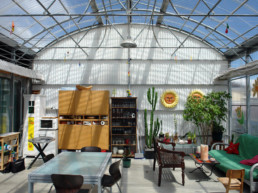March 20, 2021
Zero Waste Design: Lacaton and Vassal's creative reuse of building materials.
The Pritzker Prize in architecture was just awarded to French architects Anne Lacaton and Jean-Philippe Vassal. Recognizing the environmental costs of buildings—from the energy they use to the carbon emissions embodied in their materials—Lacaton and Vassal have focused their work on adaptive reuse. Instead of tearing down aging or obsolete buildings, they find ways of adapting existing spaces to meet new needs. (Source: FC)
“the architects are known for their ability to increase living space exponentially and inexpensively, through winter gardens and balconies that enable inhabitants to conserve energy and access nature throughout the year. meanwhile, adhering to a precept of ‘never demolish’ Source Designboom
Recycled & Chic
The Slash Objects line integrates the use of an industrial material made of post consumer recycled rubber. By pairing rubber with brass, marble and concrete, the collection imagines new ways for materials to come together.

About the Studio:
Established in Paris (1987), and have since demonstrated boldness through their design of new buildings and transformative projects. For over three decades, they have designed private and social housing, cultural and academic institutions, public space, and urban strategies. The duo’s architecture reflects their advocacy of social justice and sustainability, by prioritizing a generosity of space and freedom of use through economical and ecological materials.
Providing physical and emotional wellbeing has also been intentional in their work. Their application of greenhouse technologies to create bioclimatic conditions began with Latapie House in Floirac, France (1993). Using the sun, in harmony with natural ventilation, solar shading and insulation, they created adjustable and desirable microclimates. “From very early on, we studied the greenhouses of botanic gardens with their impressive fragile plants, the beautiful light and transparency, and ability to simply transform the outdoor climate. It’s an atmosphere and a feeling, and we were interested in bringing that delicacy to architecture,” shares Lacaton. Latapie House Latapie House, photo courtesy of Philippe Ruault Through both new construction and the transformation of buildings, honoring the pre-existing is authentic to their work. A private residence in Cap Ferret, France (1998) was built on an undeveloped plot along Arcachon Bay, with the goal of minimal disruption to the natural environment. Rather than fell the 46 trees on the site, the architects nurtured the native vegetation, elevating the home and constructing around the trunks that intersected it, allowing occupants to live among the plant life. Lacaton explains, “the pre-existing has value if you take the time and effort to look at it carefully. In fact, it’s a question of observation, of approaching a place with fresh eyes, attention and precision…to understand the values and the lacks, and to see how we can change the situation while keeping all the values of what is already there.” Their skillful selection of modest materials enables the architects to build larger living spaces affordably, as demonstrated by the construction of 14 single-family residences for a social housing development (2005), and 59 units within low-rise apartment buildings at Neppert Gardens (2015), both in Mulhouse, France; and in adjoining mid-rise buildings consisting of 96 units in Chalon-sur-Saône, France (2016); among others.
Throughout their careers, the architects have rejected city plans calling for the demolition of social housing, focusing instead on designing from the inside out to prioritize the welfare of a building’s inhabitants and their unanimous desires for larger spaces. Alongside Frédéric Druot and Christophe Hutin, they transformed 530 units within three buildings at Grand Parc in Bordeaux, France (2017) to upgrade technical functions but more notably, to add generous flexible spaces to each unit without displacing its residents during construction, and while maintaining rent stability for the occupants. “We never see the existing as a problem. We look with positive eyes because there is an opportunity of doing more with what we already have,” states Lacaton. “We went to places where buildings would have been demolished and we met people, families who were attached to their housing, even if the situation was nohttps://www.slashobjects.com/t the best. They were most often opposed to the demolition because they wished to stay in their neighborhood. It’s a question of kindness,” continues Vassal.
Find out more at Pritzker Prize







